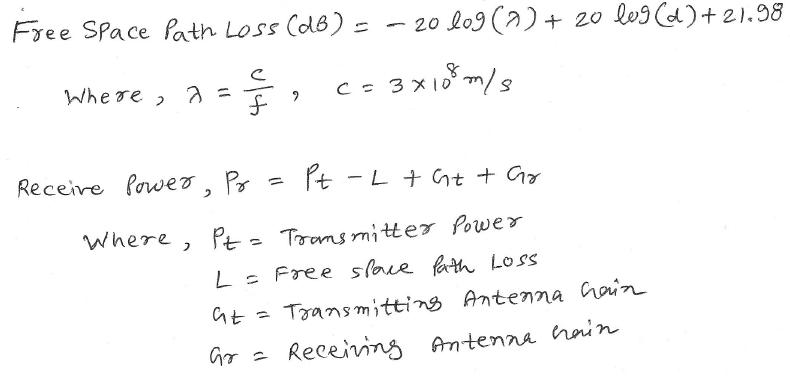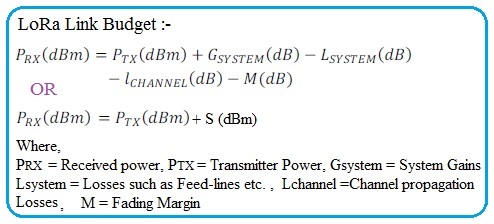There are two types of link budget calculations since there are two links namely uplink and downlink. This discussion is followed by two simple examples.
This formula takes into consideration the distance between the transmit and receive ends of the link antenna gain transmit frequency transmitter and receiver loss and other factors.

. Received power dBm transmitted power dBm gains dB losses dB Power levels are expressed in dBm Power gains and losses are expressed in decibels dB which is a logarithmic measurement so adding decibels is equivalent to multiplying the actual power ratios. Earth Station Uplink It is the process in which earth is transmitting the signal to the satellite and satellite is receiving it. D max R Esin q R Esin 2 H2 2 R.
Complete all white boxes and then click calculate button to obtain results in the green boxes. The calculator calculates the power of the received signal given amplifier and antenna gains and medium loss. To calculate the gain in dBi of the transmitting antenna and the receiving antenna.
Accounting all losses and gains from the transmitter the medium to the receiver. A simple link budget equation looks like this. The link budget is a theoretical calculation of the end-to-end performance of the communications link.
There is a minimum required associated with the minimum required service quality. It accounts for all the gains and losses of the link under a specific set of conditions and the result of. 2calculation of transmitting antenna gain.
Link Budget is a calculation used to estimate the received signal strength from a transmitter and overall system link performance between two points. What is link budget. Since this is a point-to-point link with sufficient Fresnel Zone clearance then the only losses that we need to consider when calculating the receivedpoweristhefree-space-pathlossFSPL.
Satellite Two-way Link Budgeting. 1calculation of uplink path loss. Its mathematical equation can be written as C N 0 U E I R P U G T U L O S S E S U K Where.
G TX G RX 3 215. NIST Link Budget Calculator Accounting of Link Gains Accounting of Signal Noise and Interference Powers Transmitted power dBm Link gains dB - Link losses dB - Receiver noise power dBm SNRdB Received signal powerdBm - receiver noise powerdBm INTRODUCTION. The document gives an overview and user guide about a link budget calculator for the main components of a basic OTA system.
Uplink antenna diameter m. An Excel sheet containing the Link Budget Calculator accompanies the application. Then the noise level at the receiver is estimated so we can take the ratio of the signal power to the noise power and work out the performance of the link.
Link budgets usually start with the transmitter power and sum all the gains and losses in the system accounting for the propagation losses to find the received power. Small Satellite Link Budget Calculation 746 Critical points in a Satellite Link Received power Noise Signal to noise ratio Conclusions Friis formula Antennas Polarization Propagation Maximum distance Maximum distance The maximum distance with a satellite with maximum height H and minimum elevation angle is. It is the sum of free space loss plus additional losses induced by the interaction of.
Therefore the word budget. How much you can spend on the channel loss. The calculator shall guide the user to plan link budgets especially with respect to SNR requirements for the receive components and the vector signal analyzer.
Uplink path loss dB. Range How much transmission power do you need. The tutorial provides a step-by-step approach to computing satellite link budget.
Most important steps is to calculate a link budget also called a link analysis. Equation P out P t Gt Lt Lfs Lm Gr Lr P o u t P t G t L t L f s L m G r L r. Link Budget Calculator A Link Budget puts into account all gains and losses a signal goes through in a system as it is transmitted.
A link budget calculation is important when. AP to Client link 13 20 dBm TX Power AP 10 dBi AP Antenna Gain - 2 dB AP Cable Losses-114 dB free space loss 5 km 14 dBi Client Antenna Gain - 2 dB Client Cable Losses-74 dBm expected received signal level--82 dBm sensitivity of Client 8. This application note describes a method for performing a basic link budget analysis.
Path Loss In most cases path loss is the principal contributor to loss in the link budget. A link budget calculation is also an excellent means for anyone to begin to understand the various factors which must be traded off to realize a given cost and level of reliability for a communications link. Client to AP link 14 15 dBm TX Power Client 14 dBi Antenna Gain Client - 2 dB Cable Losses Client 10 dBi Antenna Gain AP - 2 dB Cable Losses AP 35 dB Total Gain -114 dB free space loss 5 km -79 dBm expected received signal level --89 dBm sensitivity of AP 10 dB link margin Wednesday March 5 14.
Uplink antenna aperture efficiency eg. Range 35778 - 41679 km. The calculations make some assumptions and applicable to geo.
Propagation Tutorial Link Budgets

Lora Link Budget Calculator Lora Link Budget Formula

Lecture On Link Budget Youtube

Adtran Show Me Series Link Budget Calculation Youtube

Lora Link Budget Calculator Lora Link Budget Formula

Link Budget Calculation Youtube


0 comments
Post a Comment